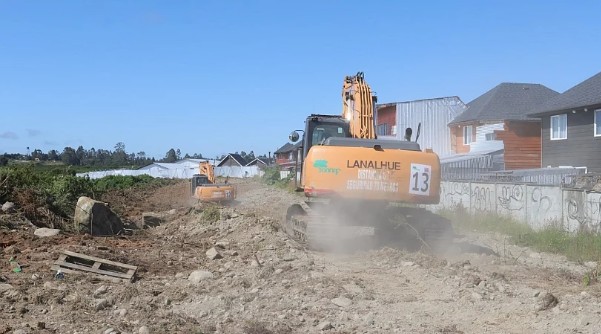Planting with Threatened Species Marks the Beginning of Future UdeC Botanical Garden
- University authorities led the planting activities of three threatened and endemic Nothofagus species from Chile.
The ruil (Nothofagus alessandrii), hualo (N. glauca), and Santiago oak (N. macrocarpa), threatened and endemic Chilean Nothofagus tree species, were the focus of the planting sessions, which mark the start of the first ex-situ collection for the future UdeC botanical garden.
Ex-situ conservation (preserving species outside their natural range) is one of the action lines of the UdeC Nature Campus project, which aims to contribute to the persistence of these three species, key to the ecology of Southern Hemisphere forests. Currently, they face a concerning decline in their natural habitats due to overexploitation, land-use change, wildfires, climate change, and other factors.
The Rector, Dr. Carlos Saavedra Rubilar, stated, "This is a highly symbolic act for the University, the city, and the country, reflecting the effort to develop a bio-socio-cultural legacy. First and foremost, it will protect biodiversity in Chile, specifically three threatened Nothofagus species in the central region. This initiative will ensure their long-term survival—3,000 plants this year and another 3,000 next year, covering at least 6 hectares. It will allow people to learn about these species in the coming years while immersed in a space for research and education, where our students will monitor their growth and foster academic engagement."
"Every time we engage with such projects, we recognize the importance of going beyond conservation—seeking the functionality of the forest and how biodiversity flourishes through this planting. As a university, we are very pleased and grateful for the international collaboration supporting this effort to protect national biodiversity," added the Rector.
Similarly, the Vice-Rector of Economic and Administrative Affairs, Dr. Miguel Quiroga Suazo, institutional sponsor of the project, affirmed, "Nature Campus holds immense value, not only for the University but also as a legacy for future generations. It will demonstrate how we can advance our mission—generating knowledge and education—while preserving unique remnants of Concepción’s ancient deciduous forest and its biodiversity, which will also be accessible for community enjoyment."
"In this context, ex-situ conservation plays a crucial role in the Nature Campus project as the University’s response to climate challenges. This conservation method involves protecting species outside their natural habitats, which is vital when those habitats and species are threatened by climate change, urbanization, agriculture, or deforestation. It also safeguards the genetic diversity of threatened species, enhancing their resilience to environmental changes and creating a biological reserve critical for their survival. Nature Campus thus becomes a space for scientific research on species adaptation to new habitats and climatic conditions," he concluded.
Likewise, the Director of the University of Concepción Corporation, Pedro Ramírez Glade, emphasized that "this activity is tremendously significant, as it marks the start of a botanical garden with the first Nothofagus species. I believe the University of Concepción will stand out globally in this endeavor, especially with species unique to Chile and under threat. I commend those who envisioned, championed, and launched this initiative."
The University of Concepción allocated 6 hectares for the future botanical garden. This area was previously covered by a plantation of exotic eucalyptus trees, 3 hectares of which were harvested between April and July this year.
Ex-situ Conservation
The Nothofagus genus comprises 37 species distributed across 7 Southern Hemisphere countries. In Chile, the ruil (Nothofagus alessandrii), hualo (N. glauca), and Santiago oak (N. macrocarpa) grow between the Metropolitan and Biobío regions, where they face a worrying decline, according to Dr. Cristian Echeverría Leal, Director of the UdeC Nature Campus project. "There is growing concern about biodiversity loss and climate change impacts on our planet’s ecosystems. Chile presents a critical scenario for biodiversity conservation. Urban pressure, deforestation, and climate change have severely affected our ecosystems, particularly the deciduous forests of central-southern Chile. Thus, ex-situ conservation emerges as a fundamental strategy, rooted in a deep commitment to biodiversity preservation and sustainable development."
"The first ex-situ collection is a significant step toward establishing the future UdeC botanical garden. With this, the University takes a leap forward in protecting these emblematic species," the academic noted, adding that the genus, also known as 'southern beech,' grows only in southern Chile and Argentina. "Of the 10 Nothofagus species in South America, three are threatened and found exclusively in Chile."
The Experience of Planting a Tree
Tatiana Bustamante Betancourt, an employee at the Faculty of Engineering, shared, "Planting a tree was something I’d wanted to do for a long time. Ironically, I mentioned this wish to colleagues during lunch, and the next day, the invitation email arrived—so I see this as a gift from the University. I’m thrilled to participate. The idea of tracking not just our sapling but the entire project is a wonderful initiative, contributing not only to society but to the planet."
Meanwhile, Vanessa Rojas Flores, a Translation and Interpretation student at UdeC’s Faculty of Humanities and Arts, believes the botanical garden initiative also plants a cultural seed. "It’s very rewarding and new to me, as my field is far from ecology or the environment. Participating was delightful, knowing this will one day be a beautiful garden where people can admire and enjoy nature—something very important. I knew this area was forested but had never accessed it before," she admitted.
The University of Concepción’s Nature Campus project is an unprecedented initiative in Chile. Grounded in science and community engagement, the university proposes a new human-nature interaction, integrating in-situ and ex-situ conservation, ecological restoration, biocultural education, and holistic well-being.

















